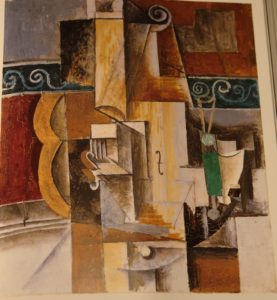Violin and Guitar (1912)

Upon my first glance at Violin and Guitar, one of the of artworks Pablo Picasso created during his Cubism period, I was amazed by how Picasso disassembles the violin into small parts and put them in such dimensional way on canvas that allow the viewers to reassemble these parts into a complete instrument while interpreting this artwork in their minds. This piece was painted during Picasso’s late period of analytical Cubism, during which I think he “subjective” the object and maximized the information while he painted. After I took a more careful look at this artwork and noticed more details, I realized he somehow combined the two string instruments together on the painting because of their certain similarities, but depicted detailed difference as well. For instance, from Picasso’s perspective, these two pieces of instrument shared the same “body”, but have different top parts: the violin has a leaned top part while the guitar has a vertical. The sound holes that only violins have also illustrate the difference. After a closer look, I realized it is the seemingly dimensional shapes in the middle of the painting that create a sense of dimension for the first impression.
Analytical Cubists works compared to impressionist works have more lines and apply more dark colors. In contrast to Monet’s artworks, Picasso’s paintings used less bright colors and have more clear and even maximized characteristics of an object. Additionally, Cubism artworks are more involved with geometry and mathematics.